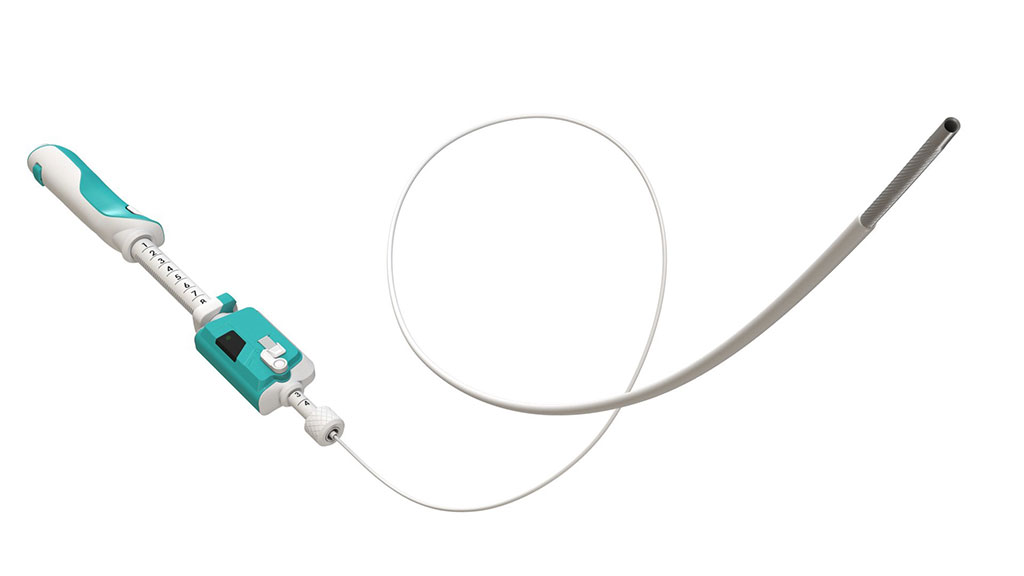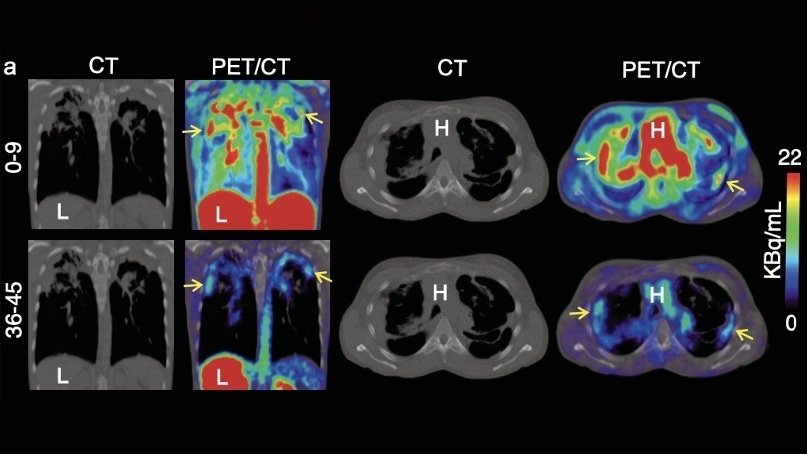Automated, Motorized Endoscopic Ultrasound Biopsy Device Advances Precision Medicine
|
By MedImaging International staff writers Posted on 04 May 2022 |

Endoscopic biopsy is performed by a gastroenterologist who accesses the targeted gastrointestinal (GI) tumor utilizing an ultrasound visualization endoscope. Suspect GI tumor locations include submucosal lesions, mediastinal masses, lymph nodes, intraperitoneal masses, and within GI related organs such as the pancreas and liver. Today's endoscopic biopsy devices have limitations in consistently obtaining quality tissue with sufficient quantity, which can result in sample tissue fragmentation, inadequate tissue amount, and blood contamination. Now, a new endoscopic ultrasound biopsy device featuring a unique motorized, automated rotational cutting needle is designed to obtain biopsies for definitive diagnosis of pancreatic cancer and other life-threatening GI cancers more quickly and less traumatically than current products.
Limaca Medical’s (Yokneam, Israel) Precision-GI device is designed to obtain tumor tissue within or adjacent to the GI tract. It is deployed and operated through an instrument channel in the endoscope to biopsy the tumor. While all existing endoscopic ultrasound fine needle biopsy (EUS-FNB) devices require manual hand operation, Precision GI features a unique motorized, automated rotational cutting needle for successful tissue acquisition. The automated design provides for more efficient and effective diagnosis of GI cancers since it is designed to yield significantly superior quality and quantity of diagnostically relevant biopsy tissue.
Initial cases from Limaca's comparative feasibility clinical study, which is ongoing, demonstrates that Precision GI obtained contiguous intact core tissue samples fully adequate for definitive diagnosis of pancreatic lesions. The clean, non-contaminated tissue samples provided a high percentage of tumor content, with less blood and extraneous fluids. Limaca’s Precision-GI endoscopic ultrasound biopsy product has received a Breakthrough Device Designation from the U.S. Food and Drug Administration (FDA). Under the program, the FDA will provide Limaca with the opportunity to provide its feedback during the pre-market phase and prioritized review of the device submission.
"We are pleased with the FDA's decision to grant the Breakthrough Device Designation to Precision-GI," said Carl Rickenbaugh, Limaca's CEO. "At Limaca, our vision is to ensure that endoscopic biopsies always achieve a definitive diagnosis to enable optimal and timely GI-cancer treatment. We are dedicated to the mission to provide a far better endoscopic biopsy experience for the endoscopist and patient, with the goal to achieve a faster, more efficient biopsy yield with highly consistent results. With the Breakthrough Device Designation, we look forward to accelerating our progress toward our goal of obtaining the FDA's 510(k) clearance to bring Precision-GI to patients in the US in the near future."
"Precision-GI is an automated, motorized endoscopic biopsy product that has the potential to improve our biopsy results for the evaluation of gastrointestinal malignancies. Endoscopic biopsy is a highly specialized, high skill procedure. We welcome the innovation of Precision-GI which can provide automation and standardization of outcomes with less variation from operator to operator," said Seth A. Gross, MD, Clinical Chief, Division of Gastroenterology and Hepatology, NYU Langone Health. "Our field is driving toward patient centric individualized cancer therapy, known as Precision Medicine, which requires consistently high quality and quantity of endoscopic biopsy tissue, enabling optimal matching of the tumor's genetic profile to personalize a patient's treatment plan."
Related Links:
Limaca Medical
Latest Ultrasound News
- Ultrasound Probe Images Entire Organ in 4D

- Disposable Ultrasound Patch Performs Better Than Existing Devices
- Non-Invasive Ultrasound-Based Tool Accurately Detects Infant Meningitis
- Breakthrough Deep Learning Model Enhances Handheld 3D Medical Imaging
- Pain-Free Breast Imaging System Performs One Minute Cancer Scan
- Wireless Chronic Pain Management Device to Reduce Need for Painkillers and Surgery
- New Medical Ultrasound Imaging Technique Enables ICU Bedside Monitoring
- New Incision-Free Technique Halts Growth of Debilitating Brain Lesions
- AI-Powered Lung Ultrasound Outperforms Human Experts in Tuberculosis Diagnosis
- AI Identifies Heart Valve Disease from Common Imaging Test
- Novel Imaging Method Enables Early Diagnosis and Treatment Monitoring of Type 2 Diabetes
- Ultrasound-Based Microscopy Technique to Help Diagnose Small Vessel Diseases
- Smart Ultrasound-Activated Immune Cells Destroy Cancer Cells for Extended Periods
- Tiny Magnetic Robot Takes 3D Scans from Deep Within Body
- High Resolution Ultrasound Speeds Up Prostate Cancer Diagnosis
- World's First Wireless, Handheld, Whole-Body Ultrasound with Single PZT Transducer Makes Imaging More Accessible
Channels
Radiography
view channel
AI Generates Future Knee X-Rays to Predict Osteoarthritis Progression Risk
Osteoarthritis, a degenerative joint disease affecting over 500 million people worldwide, is the leading cause of disability among older adults. Current diagnostic tools allow doctors to assess damage... Read more
AI Algorithm Uses Mammograms to Accurately Predict Cardiovascular Risk in Women
Cardiovascular disease remains the leading cause of death in women worldwide, responsible for about nine million deaths annually. Despite this burden, symptoms and risk factors are often under-recognized... Read moreMRI
view channel
AI-Assisted Model Enhances MRI Heart Scans
A cardiac MRI can reveal critical information about the heart’s function and any abnormalities, but traditional scans take 30 to 90 minutes and often suffer from poor image quality due to patient movement.... Read more
AI Model Outperforms Doctors at Identifying Patients Most At-Risk of Cardiac Arrest
Hypertrophic cardiomyopathy is one of the most common inherited heart conditions and a leading cause of sudden cardiac death in young individuals and athletes. While many patients live normal lives, some... Read moreUltrasound
view channel
Ultrasound Probe Images Entire Organ in 4D
Disorders of blood microcirculation can have devastating effects, contributing to heart failure, kidney failure, and chronic diseases. However, existing imaging technologies cannot visualize the full network... Read more
Disposable Ultrasound Patch Performs Better Than Existing Devices
Wearable ultrasound devices are widely used in diagnostics, rehabilitation monitoring, and telemedicine, yet most existing models rely on lead-based piezoelectric ceramics that pose health and environmental risks.... Read moreNuclear Medicine
view channel
New Imaging Solution Improves Survival for Patients with Recurring Prostate Cancer
Detecting recurrent prostate cancer remains one of the most difficult challenges in oncology, as standard imaging methods such as bone scans and CT scans often fail to accurately locate small or early-stage tumors.... Read more
PET Tracer Enables Same-Day Imaging of Triple-Negative Breast and Urothelial Cancers
Triple-negative breast cancer (TNBC) and urothelial bladder carcinoma (UBC) are aggressive cancers often diagnosed at advanced stages, leaving limited time for effective treatment decisions.... Read more
New Camera Sees Inside Human Body for Enhanced Scanning and Diagnosis
Nuclear medicine scans like single-photon emission computed tomography (SPECT) allow doctors to observe heart function, track blood flow, and detect hidden diseases. However, current detectors are either... Read more
Novel Bacteria-Specific PET Imaging Approach Detects Hard-To-Diagnose Lung Infections
Mycobacteroides abscessus is a rapidly growing mycobacteria that primarily affects immunocompromised patients and those with underlying lung diseases, such as cystic fibrosis or chronic obstructive pulmonary... Read moreGeneral/Advanced Imaging
view channel
New Ultrasmall, Light-Sensitive Nanoparticles Could Serve as Contrast Agents
Medical imaging technologies face ongoing challenges in capturing accurate, detailed views of internal processes, especially in conditions like cancer, where tracking disease development and treatment... Read more
AI Algorithm Accurately Predicts Pancreatic Cancer Metastasis Using Routine CT Images
In pancreatic cancer, detecting whether the disease has spread to other organs is critical for determining whether surgery is appropriate. If metastasis is present, surgery is not recommended, yet current... Read moreImaging IT
view channel
New Google Cloud Medical Imaging Suite Makes Imaging Healthcare Data More Accessible
Medical imaging is a critical tool used to diagnose patients, and there are billions of medical images scanned globally each year. Imaging data accounts for about 90% of all healthcare data1 and, until... Read more
Global AI in Medical Diagnostics Market to Be Driven by Demand for Image Recognition in Radiology
The global artificial intelligence (AI) in medical diagnostics market is expanding with early disease detection being one of its key applications and image recognition becoming a compelling consumer proposition... Read moreIndustry News
view channel
GE HealthCare and NVIDIA Collaboration to Reimagine Diagnostic Imaging
GE HealthCare (Chicago, IL, USA) has entered into a collaboration with NVIDIA (Santa Clara, CA, USA), expanding the existing relationship between the two companies to focus on pioneering innovation in... Read more
Patient-Specific 3D-Printed Phantoms Transform CT Imaging
New research has highlighted how anatomically precise, patient-specific 3D-printed phantoms are proving to be scalable, cost-effective, and efficient tools in the development of new CT scan algorithms... Read more
Siemens and Sectra Collaborate on Enhancing Radiology Workflows
Siemens Healthineers (Forchheim, Germany) and Sectra (Linköping, Sweden) have entered into a collaboration aimed at enhancing radiologists' diagnostic capabilities and, in turn, improving patient care... Read more





















